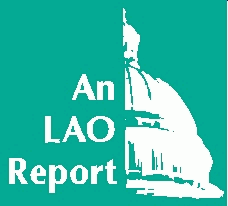 |
Legislative Analyst's Office, January 16, 1998Rethinking the
|
 |
Legislative Analyst's Office, January 16, 1998Rethinking the
|
We have concerns about some elements of the Cal-Vet reform plan—particularly its impact on the state's equity and the expansion of benefits to peacetime veterans—but believe it is reasonable overall in the short term.
We have reviewed in detail the DVA's
business reengineering and financial restructuring plans
and have concluded that, on the whole, they
represent a significant improvement in the operation of
the program that is likely to be of great benefit
to veterans and state taxpayers in the short term.
We believe, first of all, that it makes sense for
the DVA to take advantage of what appears to be a low point in interest rates to lower its bond
interest payments. A corresponding reduction in
the interest rates paid by Cal-Vet borrowers also appears justifiable, given that veterans are
now paying rates that are higher than can be
obtained from private lenders.
Preliminary calculations indicated that the
DVA's plan to stretch out Cal-Vet debt payments
another 13 years would require the state to make
$400 million in additional principal and interest payments
to retire that debt. However, our analysis
indicates that the state would effectively postpone
the payment of dollars in the short term and
increase the payment of dollars in the long term that, due
to inflation, will be less valuable. Once these effects
of inflation are taken into account (we assume an average inflation rate of 3.5 percent per year
over Most of the changes now being made in Cal-Vet operations and programs appear to be
warranted. The DVA has so far avoided the imposition
of higher insurance premiums on Cal-Vet borrowers for fire and hazard and disaster indemnity
coverages, electing instead to rein in program costs
by tightening coverages of insured losses. These coverages have been more generous than any
to be found in the private insurance market. The
focus on getting district offices to more aggressively
resell repossessed Cal-Vet properties already appears
to have paid off; the number of properties held by
the state has begun to decline.
Based upon our analysis of the Cal-Vet
program, we are concerned with several aspects of the
reform package being implemented by the DVA.
Impact on State Equity. One major cause
for concern is the failure of the DVA and the
California Veterans Board to fully assess and consider
how the restructuring of Cal-Vet finances would
affect the state's equity in the program.
At the time that the board approved a
resolution of support for the restructuring plan, neither
the DVA nor the board had obtained any analysis comparing how the state's equity would be
affected if it proceeded with the plan versus a
decision for the status quo. Given the significant amount of state funds at stake, we find this lack
of analysis and consideration of the interests of
the state's equity to be worrisome.
In fact, the implementation of the
restructuring program will significantly reduce the state's
equity in the short term. We have estimated that
the state's equity in the program in 2001 could be
as much as $80 million to $90 million lower
than would otherwise have been the case, depending upon how much the Cal-Vet interest rate is
lowered later this year. The long-term impact is unknown.
At the time this report was prepared, the DVA had
not responded to our requests for a long-range comparison of state equity under the DVA
restructuring plan versus a decision not to proceed with
restructuring of the debt and a lowering of the
Cal-Vet interest rate. The DVA has advised us that it
intends to conduct such an analysis after it has
largely completed its financial restructuring of the
Cal-Vet program.
No Analysis of Veterans' Needs. Our
second major concern is that the DVA appears to be focused upon finding ways to perpetuate the
Cal-Vet program without any analysis of whether
its loan program is really needed.
In recent years, in an effort to prevent its
loan pool from shrinking further, the DVA has
sponsored and won passage of several state legislative
measures to expand the pool of veterans eligible for
Cal-Vet loans. This has included legislation over the
last three years to bump up the amount of money
that can be borrowed to buy a home from $90,000 to $250,000; to liberalize the rules to make it
easier for a veteran to get a second Cal-Vet loan; and
to expand the periods defined in state law as
wartime service qualifying a veteran for Cal-Vet. (The DVA
is also pursuing federal legislation that would
allow use of general obligation bonds for Cal-Vet
loans without regard to when and how a veteran
served in the military, but four legislative attempts to do
so have failed.)
Each time it sought these changes, the DVA predicted that they would boost participation in
the program. Instead, the number of active
contracts has continued to diminish. This decline in
Cal-Vet loans in part reflects the fact that there are
other private-sector and governmental loan programs
that are meeting the needs of veterans.
Instead of trying to "compete" with other
taxpayer-supported programs, we believe the DVA should consider whether the needs of
California veterans are being met adequately by those
competitors. For example, the VA loan program provides a generous loan package for both
wartime and peacetime veterans, making the expenditure
of state resources to compete with it unnecessary.
Voters Have Not Approved Use of Existing
Bond Funds to Aid Peacetime Veterans. Last year,
the DVA sponsored and won passage of
Chapter 155 authorizing the granting of loans to
peacetime veterans for the first time in the 77-year history
of the program. Based on that legislative authority,
the DVA initially announced plans in September
1997 to create up to a $100 million loan pool for
peacetime veterans not otherwise eligible for loans
from its general obligation or revenue bond funds.
In December 1997, we were advised by the DVA that it does not now intend to use
the $100 million pool of "unrestricted" funds to
make loans to peacetime veterans. The DVA states that
it In our view, granting loans to peacetime
veterans is inconsistent with the Cal-Vet bond issues
approved by California voters. The electorate was
told at the time these measures went on the ballot
that the bond issues would be used for the benefit
of war veterans, not peacetime veterans. If the
Legislature wishes to expand Cal-Vet benefits to
peacetime veterans, it may wish to consider placing a
new general obligation bond issue before the
voters seeking their approval for such a program.
The DVA contends, based on the legal advice it has received from private counsel, that it
already has all the legal authority it needs to use
"unrestricted" funds for loans to peacetime
veterans. However, we have been advised by the Office
of Legislative Counsel that the proceeds of bond issues enacted by the voters prior to the
effective date of the new Military and Veterans Code
section cannot be used for loans to peacetime veterans.
We have been advised that the proceeds of future
bond acts could be used for such a peacetime loan
program if the voters approved such a bond
measure. Thus, the new code section appears to be legal, but
is not effective for "unrestricted" funds until ratified
by voters in a future bond act.
The Cal-Vet loan portfolio is likely to
continue to dwindle because of federal legal restrictions
on tax exempt state bonds and because the aging
war veteran population is buying fewer homes and
has less need for loan assistance. Veterans do
have other growing needs that are likely to create pressure for more General Fund spending.
Restructuring Will Only Slow Program Decline. We agree with the DVA that the number of new home loans generated is likely to increase.
The number of new loans issued annually could
double and may well exceed 2,000 as the department
has suggested. However, based on our analysis of
the situation, we expect that the number of loans
taken off Cal-Vet's books each year for various
reasons will continue to exceed the number of new
loans that are issued.
We believe the decline in the Cal-Vet portfolio
is likely to continue because of several factors:
What these factors generally indicate, in summary, is that the need for the Cal-Vet program
is steadily declining along with the size of the
Cal-Vet portfolio. The population of wartime veterans
that Cal-Vet has traditionally served is exiting the
home-buying market. The new group of peacetime veterans to whom Cal-Vet would like to
begin making loans has other generous lending
programs available, including several tailored specifically
for veterans, to provide them with such assistance.
Other Veterans' Problems Are
Growing. While their need for mortgage assistance is
ebbing, California's population of veterans
(estimated variously at 2.8 million to 3.2 million) has large
and growing problems. While precise numbers are not available, some estimates suggest that tens of thousands of
younger veterans in California are homeless and lack
job-training, mental health, substance abuse,
housing, and outreach services. A 1994 report by
the General Accounting Office (GAO) surveyed eight communities across the country, including
San Francisco, and concluded that the U.S. Department of Veterans Affairs' "current
programs constitute a small portion of what is likely
needed Hundreds of thousands of aging veterans are likely to require living assistance at home,
nursing home care, and hospital services, special
treatment for Alzheimer's, dementia, and alcoholism,
and other support services. In anticipation of
such needs, the state is already building four new veterans' homes in Southern California to
complement the Civil War-era home operated at
Yountville in Northern California. Veterans' groups are
also voicing concern about the lack of adequate
and available cemeteries in which to bury and
honor military veterans.
However, the state faces significant fiscal constraints that could hamper efforts to address
these problems. Given current forecasts for the growth
in state revenues, significant expansion of any
state program generally will create pressure to
either make cuts in other existing programs or
increase state revenue sources.
Major Expansion of Federal Aid Not
Likely. Although all military veterans became so as
employees of the federal government, a major expansion of federal support for veterans' programs
does not appear likely. A reduction of federal
assistance for such programs in the future appears to be
more probable.
For example, the veterans' home at
Yountville depends on the federal government for
about 53 percent of the funding needed to support
its operation. The federal balanced-budget
agreement approved by Congress and the President last
year An erosion of federal support for Yountville
and the other veterans' homes now under
development would likely leave the DVA with essentially
only three difficult choices: (1) increasing fees
for veterans who reside at the homes; (2) cutting
the cost of operating the homes, potentially
affecting services to residents; or (3) backfilling lost
federal money with the state General Fund.
There are other indications that federal assistance to California veterans is likely to be limited
in the future. For example, a 1994 GAO report on homeless veterans cast doubt as to whether
any additional aid for that group was likely to be forthcoming from the federal government. "In
an era of tight budget constraints, enhancing the services for the homeless could require
curtailing services to other veterans," the GAO concluded.
home loans is ordinarily only 10 to
12 years, much less than the 30-year term provided for most loans. This is due to
a more mobile society, major swings in mortgage interest rates, and the incentive
to refinance loans because tax-deductible interest payments decrease on older
loans. In addition, many Cal-Vet
borrowers—more than 900 per year—are paying off
their loans at the end of their regular term. That trend is likely to continue regardless
of changes made now in the Cal-Vet program. And finally, almost 200 loans per year
go off the books each year because of the death of the borrower. 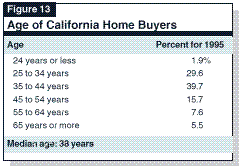
Time for a New Direction. Much has
changed since the Cal-Vet program was established 77
years ago:
Given this changing environment, we believe it
is time to rethink the basic direction that was set
for the Cal-Vet program in 1921 and establish a fundamentally new state approach to
veterans' assistance that reflects the realities of the 1990s.
In the short term, we believe the state should
follow through on the ongoing reengineering process
and ensure that the Cal-Vet program runs more
effectively. In the long run, we believe the provision
of new loan assistance through the Cal-Vet
program should be phased out and the state's
significant remaining equity in the program be redirected in
a way that will benefit both state taxpayers and veterans.
Our specific recommendations to carry out this approach are described below and are
summarized in Figure 14.
We recommend that both internal and
external oversight of the Cal-Vet program be
strengthened to ensure that the program is properly
managed and that an appropriate balance is struck
between providing tangible benefits to deserving
California veterans and protection of the interests of
state taxpayers. Strengthening Oversight. To strengthen legislative oversight of the program, we further recommend that state law
be changed to make the California Veterans Board a separate item in the state budget subject to
annual line-item appropriation by the Legislature.
The source of funding for the board would continue
to be the 1943 Act Fund, and not the General Fund. Because of the entrepreneurial nature of its
loan-making activity, we do not propose that other
Cal-Vet program operations be placed in the budget beyond those administrative positions
already appropriated through the budget act. This is
because, in our view, such a step would make it difficult for the DVA to respond and adjust to
rapid changes in the mortgage market and the economy.
The new and separate budget for the California Veterans Board should include a newly
created staff position, who would be hired by and be
held accountable to the board and who would be independent of the administrators of the DVA.
This staff position would be charged with
providing independent analysis and advice to the board
on the major policy issues and decisions on its agenda.
Because the Legislature's oversight of the
Cal-Vet program would remain limited, we believe
that state law should also be modified to strengthen
the decision-making role of the board to ensure accountability in program decision making.
An important first step in that direction was taken
with the enactment of Chapter 1145, Statutes of
1996 (SB 1470, Johannessen), which required that
the Secretary of the DVA "fully brief" the board
before making any policy change in veterans'
programs. We believe the board's role should be
additionally enhanced by requiring that off-budget staffing
and administrative expenditures of the Cal-Vet
program be reviewed and approved each year by the
board and justified by the DVA on a workload
basis. (Expenditures reviewed and approved by the Legislature would not be subject to board
approval a second time.) Finally, the DVA's business
plan, which outlines how the program will be
financed, operated, and marketed in the coming fiscal
year, should be subject to advance review and
approval by the board. The new staff analyst position
we In order to preserve program flexibility, the
DVA would retain its broad, existing authority to make
new loans to veterans, invest program funds, issue
debt, and make other key operational decisions without
the specific preapproval of the board. The board
would continue to function as an appeals board for
persons denied Cal-Vet benefits by the DVA.
Improved Reporting Requirements. The
current legislative reporting requirements for the
Cal-Vet program, in our view, need to be strengthened.
State law requires the board to report by
August 1 of each year on "the activities,
accomplishments, and expenditures of the board" during the
prior calendar year. We recommend that the board's report be changed to require that it cover
the activities of the prior fiscal year, not the
prior calendar year. The deadline for reporting could
be changed to September 1 to ensure that the board has sufficient time to prepare its report.
Existing law also requires that the Secretary
of Veterans Affairs annually commission an independent financial audit of the Cal-Vet fund. By law,
the completed audit is to be provided to the
legislative policy committees and the board. We
recommend that state law be changed to specify that
the auditor is to be commissioned by and held accountable to an audit committee of the
California Veterans Board, not the Secretary of the DVA.
In addition, the DVA should be mandated to provide a comprehensive annual report to
the Given the extensive reengineering process that
is ongoing at the DVA, we do not believe there is
a need at this time for another broad performance review of the Cal-Vet program. However,
we recommend that, once the DVA has had a chance to substantially complete its reform efforts,
the Bureau of State Audits (BSA) should be commissioned to conduct a more narrowly
targeted financial audit and program compliance review
of the program.
The BSA audit would check the accuracy of Cal-Vet financial reports, verify that eligibility rules
for the program are being enforced, determine whether staffing levels are consistent with
program workload, review cash- and debt-management practices of the program, and determine
whether the state equity in the program is being
properly preserved. Because such audits are
time-consuming both for auditors and the agency being audited,
we propose that the BSA review be delayed until
DVA reform efforts, such as the installation of a
sophisticated new computer information system,
have We believe the steps outlined above will establish the appropriate
checks-and-balances needed to ensure better operation of the Cal-Vet
program without unduly intruding on the authority of
the executive branch or the ability of the program
to adjust to changing economic conditions. Our recommendations for improving oversight of
the Cal-Vet program are summarized in Figure 15.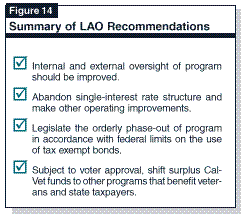
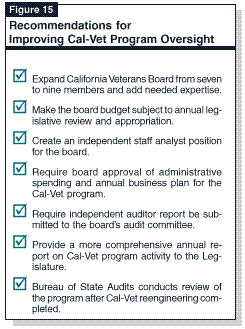
We recommend that the Cal-Vet program
be restructured so that future Cal-Vet loans could
be issued at an interest rate different, if
necessary, from the rate established for previous
Cal-Vet borrowers. Other short-term program
improvements to complete the reengineering process
begun by the Department of Veterans Affairs should
also be encouraged.
Abandon Single-Interest Rate. Consider the difficult situation in which
interest rates are rising and it becomes more expensive
for the program to borrow funds through bond
issues. In such an event, the program can leave unchanged the rate it charges to its borrowers,
and issue loans to new borrowers at rates that will
result in financial losses to the program year after year.
In the alternative, the interest rate can be raised for
all borrowers—an unpopular step likely to
create financial difficulties for many veterans.
We recommend that state law be changed to allow the program to issue new loans at
rates commensurate with the cost to the state of borrowing the bond funds used to fund those new
loans. Veterans may have to pay a higher rate than
prior Cal-Vet borrowers, but they would still receive
a real benefit from the state. Even those higher interest rates could be lower than they might
obtain in the private sector.
One additional benefit of this approach is that
the Cal-Vet program could essentially "lock in" the
new, lower loan rates it hopes to achieve through
its ongoing restructuring of program finances. Most
of the 39,000 present Cal-Vet borrowers would be assured that the rate reduction that they are
scheduled to receive this April will never be reversed.
Report on Reengineering Progress. We
recommend that, at the time of its budget hearings,
the DVA also update the Legislature regarding its progress in implementing the operational
improvements specified in its Cal-Vet reengineering
program. In particular, the DVA should indicate:
Limit Use of Revolving Fund to War
Veterans. We also recommend that the $100 million pool
of "unrestricted" funds that the DVA is now
setting aside for veterans of recent wars (primarily
the Persian Gulf, Panama, and Grenada military
incursions) be limited to that purpose and not be
used for loans to peacetime veterans. As we noted earlier in this report, Legislative Counsel has
advised that the proceeds of bond issues enacted by
the voters for the benefit of war veterans cannot be
used to make loans to peacetime veterans. Lacking
such voter approval, we believe that loans from
the $100 million revolving fund should go only to
war veterans of these more recent conflicts who until
now have had only a limited opportunity to obtain
Cal-Vet benefits. The exact criteria for eligibility should
be determined, as current law provides, by the
California Veterans Board.
We believe these recommendations would ensure that the Cal-Vet program operates
more efficiently, fairly, and with fewer financial
problems.
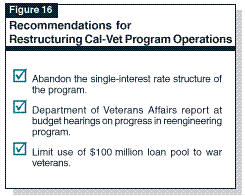
We recommend the enactment of state
legislation directing the orderly phase-out of issuance
of new Cal-Vet loans by the year 2007. The legislation would also ensure the proper stewardship
of the Cal-Vet loan and bond portfolios until
their expiration.
Program Slowdown Inevitable. For these reasons, we believe the state needs
an "exit strategy" for the Cal-Vet program. In our
view, it is time to enact state legislation establishing
a clear timetable and process for phasing out all
new Cal-Vet loan activity as of January 1, 2007. At
that point, the state will have no choice under
federal tax law but to terminate the issuance of loans
using the proceeds of general obligation bond
funds, which has been the source of 90 percent of
program finances. We recommend that issuance of new loans using other sources of funds and
revenue bonds also be phased out at the same time.
We are not recommending that all program functions be terminated in 2007.
Loan-servicing, debt management, and cash management
operations must continue in some form until all
outstanding loans and bonds have been retired
sometime before the year 2032. New loan activity,
however, would cease.
No outstanding Cal-Vet loan to any veteran would be affected; a Cal-Vet borrower
would Needs of Peacetime Veterans Would Be
Met. The phase-out of new loan activity in 2007 that
we have proposed also means the state would not carry on in the long term with a new home
loan program for peacetime veterans. This is because
we believe the needs of creditworthy peacetime veterans for substantial housing assistance
will continue to be met through both the
private-sector housing market and various governmental
programs.
Future governmental assistance from other quarters does not appear to be in question.
For example, federal VA and FHA assistance
programs are now self-funded operations largely
immune from federal budgetary constraints and thus
are highly likely to continue to provide home loans
to veterans. Moreover, many veterans will continue
to qualify for assistance under the state's CHFA
loan programs, which offer loans at interest rates
well below what Cal-Vet has been charging.
Put Loan Servicing Out to Bid. As part of
the Cal-Vet phase-out legislation, we recommend
that the Legislature direct the Department of
General Services (DGS) to conduct a procurement of
loan services for the Cal-Vet portfolio by January
1, 2006. The DGS would be empowered to determine which specific loan-servicing functions would
be procured and would issue and administer the request for proposals. If the DVA could
demonstrate, through the bidding process, that it is
the We believe these recommendations would ensure that the Cal-Vet program is phased out in
an orderly and cost-efficient manner, preserving
the state's equity in the program while ensuring
proper management of the outstanding loans and
debt. Our recommendations for the orderly phase-out
of new Cal-Vet loan activity are summarized in Figure 17.
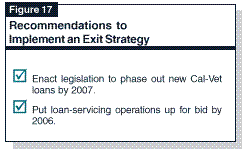
We recommend that surplus funds be shifted
to programs that will benefit both California
veterans and state taxpayers. This should be
accomplished carefully by means that ensure that all
obligations of the state to bondholders are met and that
the program retains adequate reserves to meet the requirements of the program.
Tap Reserves to Meet Growing Needs. Given this projection, and the substantial and growing needs of California's aging veteran
population, we believe it makes sense to begin using
those resources in a prudent fashion to address
those needs. Thus, we recommend that, if
California voters concur, surplus funds should be
channeled into other programs that will benefit both
veterans and state taxpayers.
The first task is to determine the size and the timing of the availability of that surplus.
Accordingly, we recommend the enactment of budget
bill language directing the DVA to provide the
Legislature with an analysis of the 1943 Act Fund,
the main revolving fund for Cal-Vet operations.
This analysis, which will probably require the assistance of the DVA's cash-flow and
debt-management consultants, should detail how much
of the current cash and investment assets of the program are now needed for prudent reserves
to ensure the repayment of the outstanding Cal-Vet debt and to provide all funding needed for
loan and related insurance program operations. The analysis should also project how much
reserve funding is needed year by year for the duration
of the program, and the amount of surplus funds
that could be available for appropriation for
other purposes in each year. The analysis would be
based upon the assumption that the issuance of new
Cal-Vet loans would cease by the year 2007 in
accordance with federal restrictions on general
obligation bonds.
The DVA would also analyze its existing agreements with bondholders, bond insurers, and
bond rating agencies, as well as any relevant sections
of the federal tax code, to ensure that they would
not be violated by a future redirection of surplus
Cal-Vet funds.
We further recommend that state law require that the Veterans Finance Committee of
1943 conduct a review to verify that only truly
surplus funds are transferred from the Cal-Vet fund, that
all obligations to bondholders are met, and that
any transfers would not violate federal tax code
restrictions. Their analysis, along with any comments
of the Veterans Finance Committee, should be completed and submitted to the Legislature by
January 1, 1999.
How Surplus Funds Could Be Used. Once
the DVA has determined if and when surplus Cal-Vet funds could be available for other programs,
the next major task is to determine how they could
best be used to benefit both veterans and state
taxpayers. In our view, the funds should be used for
the We can suggest several possibilities that would meet both of our criteria. For example: Before appropriation of any surplus Cal-Vet funds could occur, we recommend that the
California Veterans Board be directed to conduct
public hearings to solicit testimony of veterans and
the general public as to the best use of the funds
that ultimately become available. The board, with
the assistance of the DVA, should also be directed
by law to recommend policies and priorities to the Seek Voter Approval of Funding
Shift. Before any shift of surplus Cal-Vet funds to other
purposes occurs, we recommend that California voters
be asked to authorize such an action. We recommend that such approval be sought for limited
purposes specified by the Legislature in a future statewide
ballot measure. The DVA has indicated that another
Cal-Vet general obligation bond issue may need to be
placed on the statewide ballot in the year 2000 if the
proceeds of previous bond issues are exhausted. In
that event, it may be possible to include a
funding-shift provision in the next bond issue submitted to voters.
Under our proposal, funding for any new program would be determined by the
Legislature on the basis of the hearings conducted and
subsequent recommendations of priorities received
from the California Veterans Board. The new
programs for veterans that would be designated as
potential recipients of surplus funds would be specified
in the ballot measure presented to voters.
The DVA concluded in a 1995 memorandum that surplus Cal-Vet funds could not be
reallocated to other programs by statute alone. The
memorandum by DVA's then-chief attorney referenced
a 1974 Third District Court of Appeal ruling
(Veterans of ForeignWars v. State of
California). In that case, the court struck down the legislative redirection
of $500,000 per year of the Cal-Vet operating fund
to support of CVSOs' operations between 1965 and 1973. The court held that the redirection of
the funds was not permissible because the
redirection of funds through the state budget act amounted
to The Legislative Counsel's office has advised us that, given the 1974 court precedent, voter
approval would be needed before surplus Cal-Vet funds could be redirected to other
purposes. Legislative Counsel has also advised us that use
of surplus funds also faces potential legal
hurdles stemming from federal tax code restrictions on
the use of the proceeds of tax exempt bonds and
the state's obligation to bondholders. Accordingly,
we have recommended above that the Veterans Finance Committee of 1943 review any plan
to redirect Cal-Vet funds to other purposes to
verify that all of the state's legal obligations are met.
Circumstances have changed significantly since the court issued its ruling almost 24 years ago.
At the time of the ruling, issued just as the
Vietnam conflict was ending, the court noted that the
ranks of veterans were growing and that the DVA
was planning another bond issue to meet the anticipated heavy demand for a new wave of
veterans being discharged from military service.
These factors led the court to conclude that no
surplus was actually available in the 1943 Act Fund to
be redirected.
The situation is now different. Demand for Cal-Vet loans, and the size of the Cal-Vet loan
portfolio, has been dropping since the early 1980s.
Federal restrictions on use of general obligation bonds
will have the practical effect of halting any issuance
of new loans from this funding source as of 2007. Meanwhile, the veteran population is aging
and In any event, we believe it is prudent to
require that any redirection of surplus funds for
other purposes be ratified by the electorate.
California voters financed Cal-Vet loans through their
repeated approval of bond issues and, thus in our view, it is reasonable that they should have a say
in regard to the use of funds generated by the program. We believe such a measure needs to be
well-crafted to include strong protections for the
loan program and bondholders.
The alternative, if the DVA's projections prove accurate, is to allow as much as $600 million
in state equity in the Cal-Vet program to
accumulate and be left unused over the next 34 years. If none
of the state's equity can be accessed until all
Cal-Vet bonds are retired as scheduled—a date the
financial restructuring plan will delay until as late as the
year 2032—few veterans alive today will receive
any benefit from the surplus they helped generate
through their participation in the Cal-Vet program.
We believe the above recommendations will ensure that the changing needs of
California's veteran population are met without
creating additional fiscal demands on state government.
Our recommendations for shifting Cal-Vet program resources for these purposes are summarized
in Figure 18.
those counties suffering fiscal
problems. Expansion of state assistance to CVSOs might assist more veterans in
obtaining federal VA pension and medical benefits and reduce their reliance upon
state-funded Medi-Cal and Supplemental Security Income/State Supplementary Program
(SSI/SSP) programs. The Legislature and the Governor recently enacted
Chapter 318, Statutes of 1997 (SB 608,
Johannessen) specifying legislative intent that
$5 million be provided to expand CVSOs. Surplus
Cal-Vet funds could be a source of such funding in the future.
July 1, 1998, of the operational and capital outlay needs for providing services
for veterans who suffer from Alzheimer's disease and dementia. Should the
study find a need for additional programs and facilities, they could be funded with
surplus Cal-Vet funds, benefiting veterans and saving state taxpayers a new demand
on the General Fund.
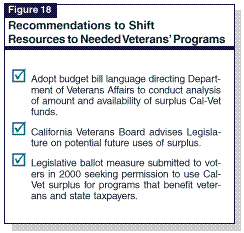
In our view, our recommendations would
ensure that the work the DVA has already begun to
reform the Cal-Vet program is carried though to a
successful conclusion. We also propose an exit strategy
for the orderly phase-out of the program. Further,
we propose to revamp the state's array of
veterans' programs with the voters' permission to meet
the changing needs of the veteran population using
the anticipated surplus no longer needed for the program.
Figure 19 shows the timetable
of activities we recommend be set in motion by
state legislation.
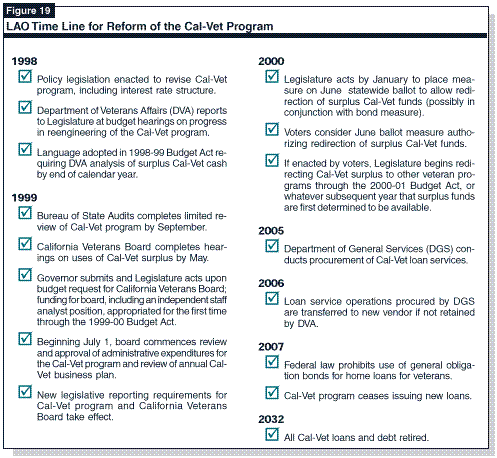
| Acknowledgements This report was prepared by and Craig Cornett, with the assistance of many others throughout the office. The Legislative Analyst's Office (LAO) is a nonpartisan office which provides fiscal and policy information and advice to the Legislature. | LAO Publications
To request publications call (916) 445-2375.
|